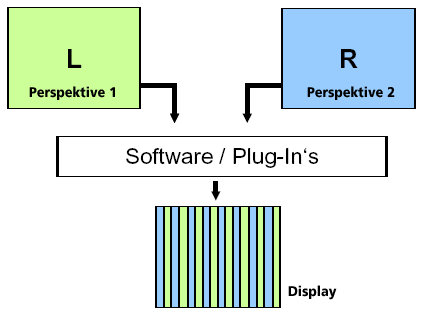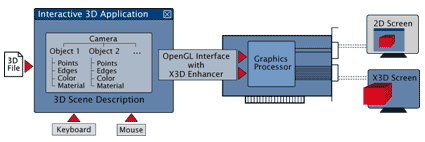3D Stereo Technology: Is it Ready for Prime Time?
Autostereoscopic Displays
As the name implies, autostereoscopic displays can create a 3D effect without having to rely on any extra devices like shutter glasses. The manufacturers attempt to use optical tricks to aim the waves of light emitted by the monitor directly at the viewers eyes. If the viewer's head is within a certain area in front of the screen, the so-called stereo zone, the scene will appear to be in 3D.
In this case, the effect is achieved with a normal TFT display that has been adapted by adding a "lens plate" designed and manufactured specifically for this one model. The lenticular lenses refract the light in such a way that each of the viewer's eyes only sees one row of pixels. For example, the left eye would see all even-numbered lines, while the right eye sees the odd-numbered ones. Appropriate software then arranges for the stereoscopic image output. The result is that the viewer can now see a real, 3D environment when situated within a certain area before the screen, without the need for any extra devices.
The rows of pixels are split up. The even-numbered rows display the image for the left eye, while the odd-number show that for the right eye.
A thin sheet of plastic explicitly designed for a certain display carries rows of vertically aligned lenticular lenses. These refract the light directly towards the eyes of the viewer.
This creates a "stereo zone" in a narrowly defined area in front of the display in which a stereoscopic depiction is possible.
Unfortunately, even this 3D stereo technique has its drawbacks. First, it suffers from a reduced horizontal resolution. An autostereoscopic display with a native resolution of 1600x1200 effectively only has 800x1200 pixels, since each eye only sees every other pixel. The brain then combines these two half-images to form the stereoscopic image, but that doesn't change the fact that the resolution of the image is lower. Next, this type of display is inherently incapable of displaying any kind of 2D image, as the lenses always refract the light into a stereoscopic image. The third big disadvantage is the size of the defined stereo zone; if the viewer moves outside of the area, the image becomes inverted - hills become valleys, and vice versa.
A typical workplace with a 3D display: a normal (2D) monitor is used for conventional work, while the 3D display next to it is used for 3D display.
Get Tom's Hardware's best news and in-depth reviews, straight to your inbox.
Eye tracking systems based on little cameras can give the user greater freedom of movement by adjusting the lens plate in real time. Again, there is a down side to this approach, though: it makes the entire setup much more expensive.



